|
Forms from the Natural
World
by Bob Brooke
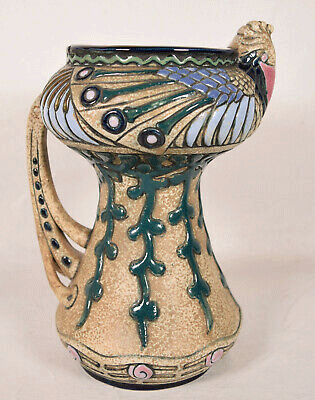 Clay
was the perfect medium for the Art Nouveau aesthetic. Its malleable
organic nature let turn-of-the-20th-century potters shape it into the
sinewy lines, feminine curves, and scrolling vines so characteristic of
this new style. The introduction of new glazing techniques added bright
contrasting colors, which stood out from previous traditionally made
works. Clay
was the perfect medium for the Art Nouveau aesthetic. Its malleable
organic nature let turn-of-the-20th-century potters shape it into the
sinewy lines, feminine curves, and scrolling vines so characteristic of
this new style. The introduction of new glazing techniques added bright
contrasting colors, which stood out from previous traditionally made
works.
Art Nouveau was more about discarding rigid design rules and creating
beautiful, asymmetrical, and sensual objects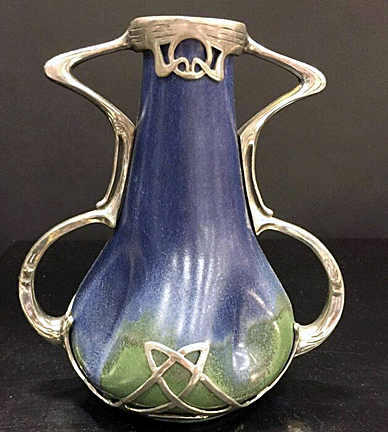 ,
so that utilitarian craft pieces were as gorgeous as works of fine art. ,
so that utilitarian craft pieces were as gorgeous as works of fine art.
The new movement inspired major china and dinnerware manufacturers
around Europe and the United States to open boutique art pottery
studios, where gifted potters and chemists were often given free range
to experiment, throw pots by hand, and test glazing techniques. For this
reason, Art Nouveau was responsible for a variety of innovations, and
Art Nouveau ceramics easily identified by which new techniques potters
used.
Some studios focused on their glazes and firing techniques, striving to
achieve the perfect color, opacity, and texture. In particular, the
firing process often led to unpredictable outcomes, such as uneven
color, veins, or blisters—such “imperfections” gave each piece a unique
character. Often the plainly shaped pots acted as blank canvases artists
adorned with beautiful colors, textures, and painted imagery.
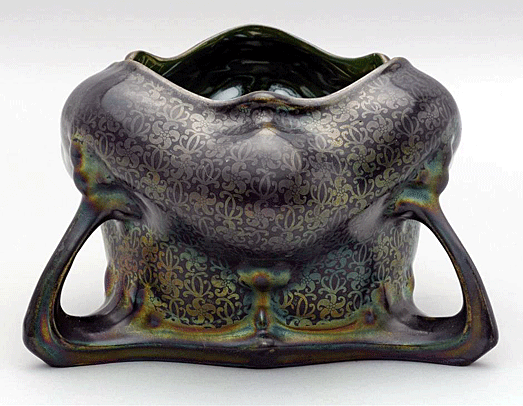
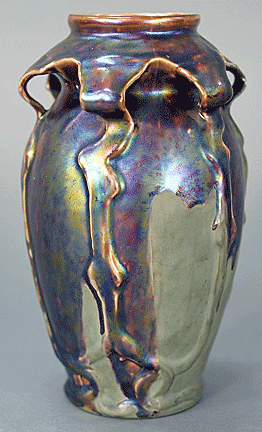 Other
ceramists put their energy into creating unique shapes for their pots,
making fluid-looking vases inspired by Japanese ceramics and shaped like
flowers or foliage. Art Nouveau potters achieved three-dimensional
relief effects by sculpting damp clay into flower blooms, plant stalks,
animals, or maidens. They shaped handles like scrolls, branches, leaves,
or even seductively arching women. Other
ceramists put their energy into creating unique shapes for their pots,
making fluid-looking vases inspired by Japanese ceramics and shaped like
flowers or foliage. Art Nouveau potters achieved three-dimensional
relief effects by sculpting damp clay into flower blooms, plant stalks,
animals, or maidens. They shaped handles like scrolls, branches, leaves,
or even seductively arching women.
Art Nouveau pottery produced by major factories, as opposed to
individual artists, tended to emphasize surface decoration over
experimental glazes. These pieces were adorned with imag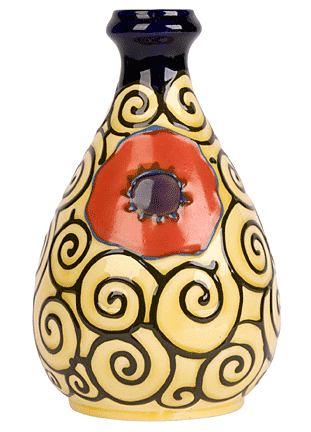 ery
inspired by Viennese Secessionists and Jugendstil artists as well as
Japanese art, including blooming plants, exotic birds like peacocks, and
the hugely popular femme-fleur, or flower woman. ery
inspired by Viennese Secessionists and Jugendstil artists as well as
Japanese art, including blooming plants, exotic birds like peacocks, and
the hugely popular femme-fleur, or flower woman.
Potters used slip, or colored liquid clay, to decorate their pots. The
Minton Pottery favored “tube-lining” in which artists squeezed slip onto
a vase in thin lines. Tube-lining helped prevent the bright, contrasting
paints from bleeding into one another. In the barbotine and impasto
techniques, employed by Doulton & Company, decorators employed slips of
different colors like oil paints, and in some cases, overlapped them.
French Pottery
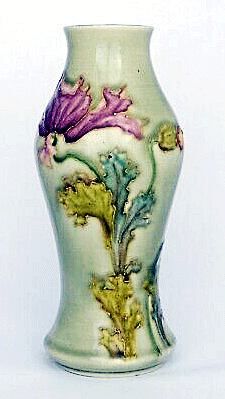 In
France, the top luxury commercial pottery Sèvres paved the way for new
glazing techniques when Joseph-Théodore Deck took the helm in 1883. The
firm’s potters took their inspiration from the female body as well as
Chinese architecture and ancient Turkish, Persian, and Far Eastern
pottery. Artists then painted the pieces in subtle pastel colors. In
France, the top luxury commercial pottery Sèvres paved the way for new
glazing techniques when Joseph-Théodore Deck took the helm in 1883. The
firm’s potters took their inspiration from the female body as well as
Chinese architecture and ancient Turkish, Persian, and Far Eastern
pottery. Artists then painted the pieces in subtle pastel colors.
One distinguishing feature of certain Sèvres Art Nouveau vases is the
gilt-bronze mount, also called a plinth, which usually complements the
theme of the pot. A vase painted with Monet-esque lily pads, for
example, might have golden frogs hugging its base.
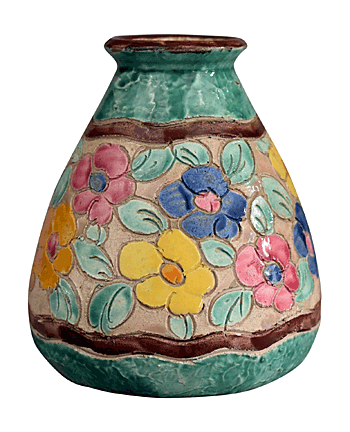 Clément
Massier, who owned a family pottery, also tinkered with glazes,
developing a line of iridescent and luster glazes in earthy, somber
tones that gave his earthenware the look of glass. His company
collaborated with Symbolist painter Lucien Levy Dhurmer, who decorated
Massier vases in Art Nouveau styles. Dhurmer used vibrant colors taken
from red flowers, green grass, and turquoise seas. Clément
Massier, who owned a family pottery, also tinkered with glazes,
developing a line of iridescent and luster glazes in earthy, somber
tones that gave his earthenware the look of glass. His company
collaborated with Symbolist painter Lucien Levy Dhurmer, who decorated
Massier vases in Art Nouveau styles. Dhurmer used vibrant colors taken
from red flowers, green grass, and turquoise seas.
Dutch, German, and Bohemian Pottery
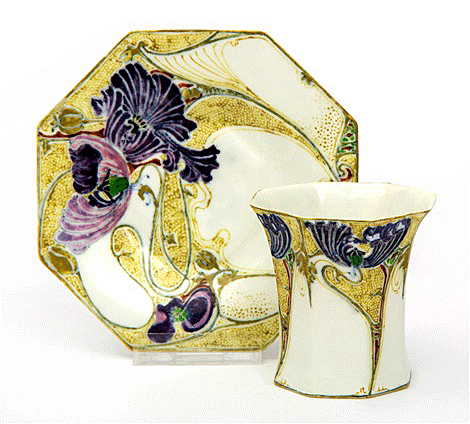 The
Rozenburg factory, based in The Netherlands, contributed major
innovations in the shapes of Art Nouveau pottery. There, in 1899,
Jurriaan Kok and M.N. Engelden introduced their “eggshell porcelain,” an
extremely thin and lightweight earthenware, strengthened by glazing on
the inside and out. This fine and delicate pottery featured intricate
images of flowers, insects, and birds painted by Samuel Schellink and R.
Sterken. The
Rozenburg factory, based in The Netherlands, contributed major
innovations in the shapes of Art Nouveau pottery. There, in 1899,
Jurriaan Kok and M.N. Engelden introduced their “eggshell porcelain,” an
extremely thin and lightweight earthenware, strengthened by glazing on
the inside and out. This fine and delicate pottery featured intricate
images of flowers, insects, and birds painted by Samuel Schellink and R.
Sterken.
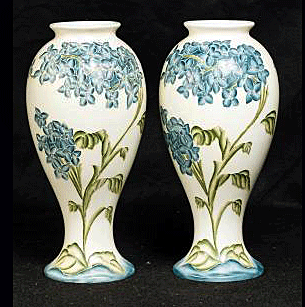
Major German potteries like Meissen and Königliche Prozellan Manufaktur
(K.P.M.) Took advantage of Art Nouveau’s popularity and began adopting
these decorative painting styles on their vases. Staatlich Porzellan
Manufaktur in Meissen even contracted with designers like Herny van de
Velde and Peter Behrens to help give their pieces a more up-to-date
appearance.
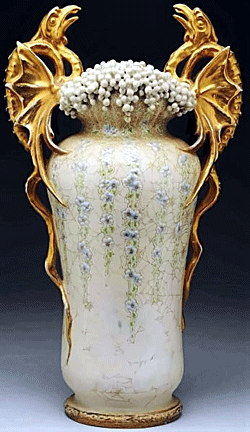 The
Reissner, Stellmacher & Kessel (R.S.K.) Company dubbed its most
ambitious line of Bohemian Art Nouveau pottery Amphora. This pottery
featured exotic and organic shapes, with incised or relief-molded
decorations of flowering and fruiting plants, painted in bright surface
enamel. Potters shaped handles like branches with extreme curves. The
Reissner, Stellmacher & Kessel (R.S.K.) Company dubbed its most
ambitious line of Bohemian Art Nouveau pottery Amphora. This pottery
featured exotic and organic shapes, with incised or relief-molded
decorations of flowering and fruiting plants, painted in bright surface
enamel. Potters shaped handles like branches with extreme curves.
The painted decorations on Amphora pottery, inspired by Jugendstil,
often highlighted the daydreaming, pale face of a woman, surrounded by
tendrils of long hair and a gilt halo. These Amphora stylings were so
popular, R.S.K. applied them to wall masks, sculptural figures, and
earthenware pots adorned with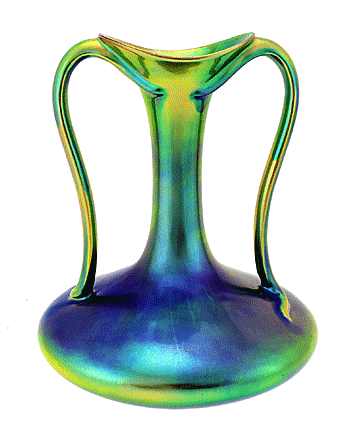 glass cabochons.
glass cabochons.
Another innovative Bohemian company, Zsolnay, made breakthroughs in
lustrous and iridescent glazes. Gifted chemist Vincse Wartha helped
Zsolnay introduce a wide line of marbled, shaded, and crystalline
glazes. The most popular of these was the iridescent glaze known as
“eosin.” Zsolnay pottery featured simple nature-inspired reliefs like
trees set against lustrous red skies.
English Pottery
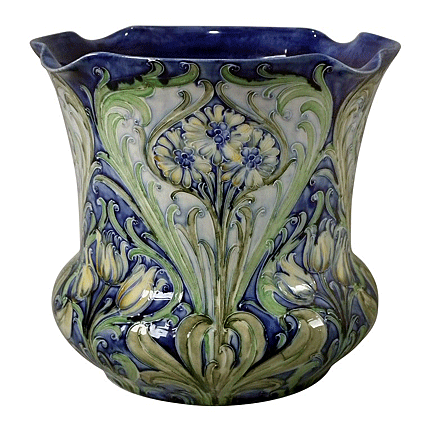 In
England, ceramist William Moorcroft used the tube-lining technique for
his popular line of Florian ware Art Nouveau pottery, outlining his
imagery, inspired by Etruscan, classical Roman, and Far-Eastern pottery,
with thin pipes of colored slips. Designer Christopher Dresser also
employed tube-lining for his work at the Minton Art Pottery studio,
where Minton & Company provided artists with blank vases to paint.
Company artistic director Leon Solon worked In
England, ceramist William Moorcroft used the tube-lining technique for
his popular line of Florian ware Art Nouveau pottery, outlining his
imagery, inspired by Etruscan, classical Roman, and Far-Eastern pottery,
with thin pipes of colored slips. Designer Christopher Dresser also
employed tube-lining for his work at the Minton Art Pottery studio,
where Minton & Company provided artists with blank vases to paint.
Company artistic director Leon Solon worked
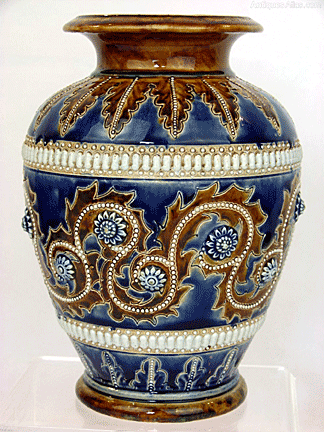 with
John Wadsworth on a popular series of “Vienna Secessionist” inspired
pieces for Minton. with
John Wadsworth on a popular series of “Vienna Secessionist” inspired
pieces for Minton.
Doulton & Company., known as Royal Doulton after 1901, opened a studio
in south London in 1871 to produce a hand-crafted, hand-decorated Art
Nouveau style pottery. The firm used the artists of the Lambeth School
of Art, including Frank Butler, Hannah Barlow, George Tinworth, and
Emily Edwards. These artists were able to chose the shape and decoration
of the vases they produced. Their pots were usually simple in form and
adorned with flora or fauna patterns.
American Pottery
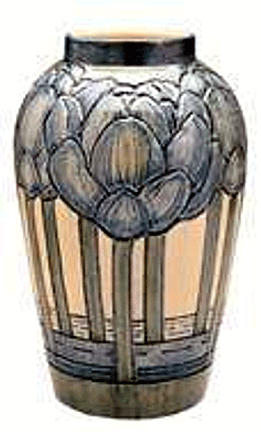 Newcomb
Pottery, which was part of H. Sophie Newcomb Memorial College in New
Orleans. Student potters at the all-female college hand threw and
hand-painted the pieces. Now an adjunct of Tulane, the school produced
pots by highly talented instructors and designers like Sadie Irvine,
Henrietta Bailey, Harriet Joor, and Anna Frances Simpson. Pieces made
between 1898 and 1910 are the most collectible. Newcomb
Pottery, which was part of H. Sophie Newcomb Memorial College in New
Orleans. Student potters at the all-female college hand threw and
hand-painted the pieces. Now an adjunct of Tulane, the school produced
pots by highly talented instructors and designers like Sadie Irvine,
Henrietta Bailey, Harriet Joor, and Anna Frances Simpson. Pieces made
between 1898 and 1910 are the most collectible.
Artist George Ohr of Biloxi, Mississippi, was perhaps the most
remarkable American Art Nouveau potter. He made shockingly modern and
bri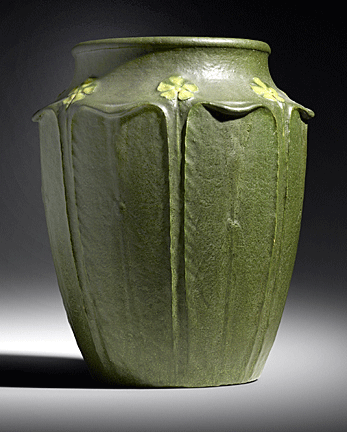 ghtly
colored pots with paper-thin walls that turn, twist, and ripple in
stunning organic shapes. Ohr dug the clay himself, formulated his
glazes, and even built his pottery and kiln. ghtly
colored pots with paper-thin walls that turn, twist, and ripple in
stunning organic shapes. Ohr dug the clay himself, formulated his
glazes, and even built his pottery and kiln.
William Grueby also created a distinct American line of Art Nouveau
pottery when he opened his Grueby Faience Company in Boston with the
goal of pursuing “organic naturalism.” His firm invented fine vegetal
matte glazes. When its pottery had been shaped, colored, and fired, it
came out looking remarkably like they had been made of broad, living
leaves and gourds. While the pots were usually green, Grueby also
employed its high-quality matte glazes in a variety of colors to make
beautiful ceramic tiles.
< Back
to Collectibles Archives
Next Article >
|
